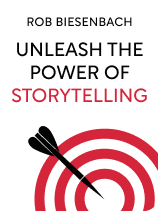

This article is an excerpt from the Shortform book guide to "Unleash the Power of Storytelling" by Rob Biesenbach. Shortform has the world's best summaries and analyses of books you should be reading.
Like this article? Sign up for a free trial here.
Do you look at your career as just a timeline with points on it? What if you saw it as a story?
Whether you realize it or not, your career has a narrative. It has a beginning, a middle, and an end (in the past or in the future). You’re the main character who has certain motivations and faces obstacles along the way.
Keep reading to learn how putting your career story into words can be powerful for colleagues, prospective employers, and even yourself.
Your Career Story
When you interview for a job or introduce yourself to someone new, you should frame your career as a story. This makes it more memorable, reveals why you do what you do, and can even help explain an unconventional path if needed. Having a career story is also useful when you’re facing a crisis or a decision and need help staying focused on your priorities.
Biesenbach cites the advice to find the “implicit narrative” of your life: Identify the values, character traits, and skills that have driven you through your most significant successes and challenges. Recall feedback that you’ve received from others, and articulate what you’ve enjoyed about your work.
(Shortform note: The “implicit narrative” is just one framework for using stories to think about the purpose you’re trying to fulfill in your career. In Find Your Why, David Mead, Peter Docker, and Simon Sinek recommend having a “purpose discussion” to identify your core values and purpose. They recommend gathering stories and lessons from your life that are meaningful to you, noticing the themes of those stories, and then drafting a purpose statement to articulate the action that your purpose compels you to take and the impact you want that action to have.)
Biesenbach recommends crafting your personal narrative with the same basic five-part structure he recommends for any story:
- Normal state (the status quo)
- Inciting incident (the event that upsets the status quo)
- Turning point (the action the character takes to respond to the inciting event)
- Conflict (the obstacles that complicate the character’s path)
- Resolution (the conclusion, where the character either gets what they want or doesn’t, but in either case learns something)
Structure gives shape to the story so that it has conflict and draws the reader into the action. At the beginning of your story, you’re enjoying your status quo. Then, an inciting incident disrupts that status quo. Next, the story comes to a turning point, where you respond to the inciting incident. Conflict occurs as you face challenges. At the end, you reach a resolution.
(Shortform note: Biesenbach’s emphasis on the “inciting incident” is grounded in a long tradition of thinking [and writing] about stories. In Story, Robert McKee explains that the inciting incident—the event that compels a character to action—functions as one of the key parts of a story’s structure. As you might notice in the change from “normal state” to “inciting incident” in Biesenbach’s structure above, the inciting incident throws the character out of their status quo and forces them to take action toward their goal. [Their goal might just be to return to the status quo!] The inciting incident poses a question—will the character reach their goal?—and later in the story, the climax or resolution answers that question.)

———End of Preview———
Like what you just read? Read the rest of the world's best book summary and analysis of Rob Biesenbach's "Unleash the Power of Storytelling" at Shortform.
Here's what you'll find in our full Unleash the Power of Storytelling summary:
- How telling a story can make any message more compelling
- The unique power stories have to influence us and shape our emotions
- The crucial pieces that make up a story (other than the beginning, middle, and end)






